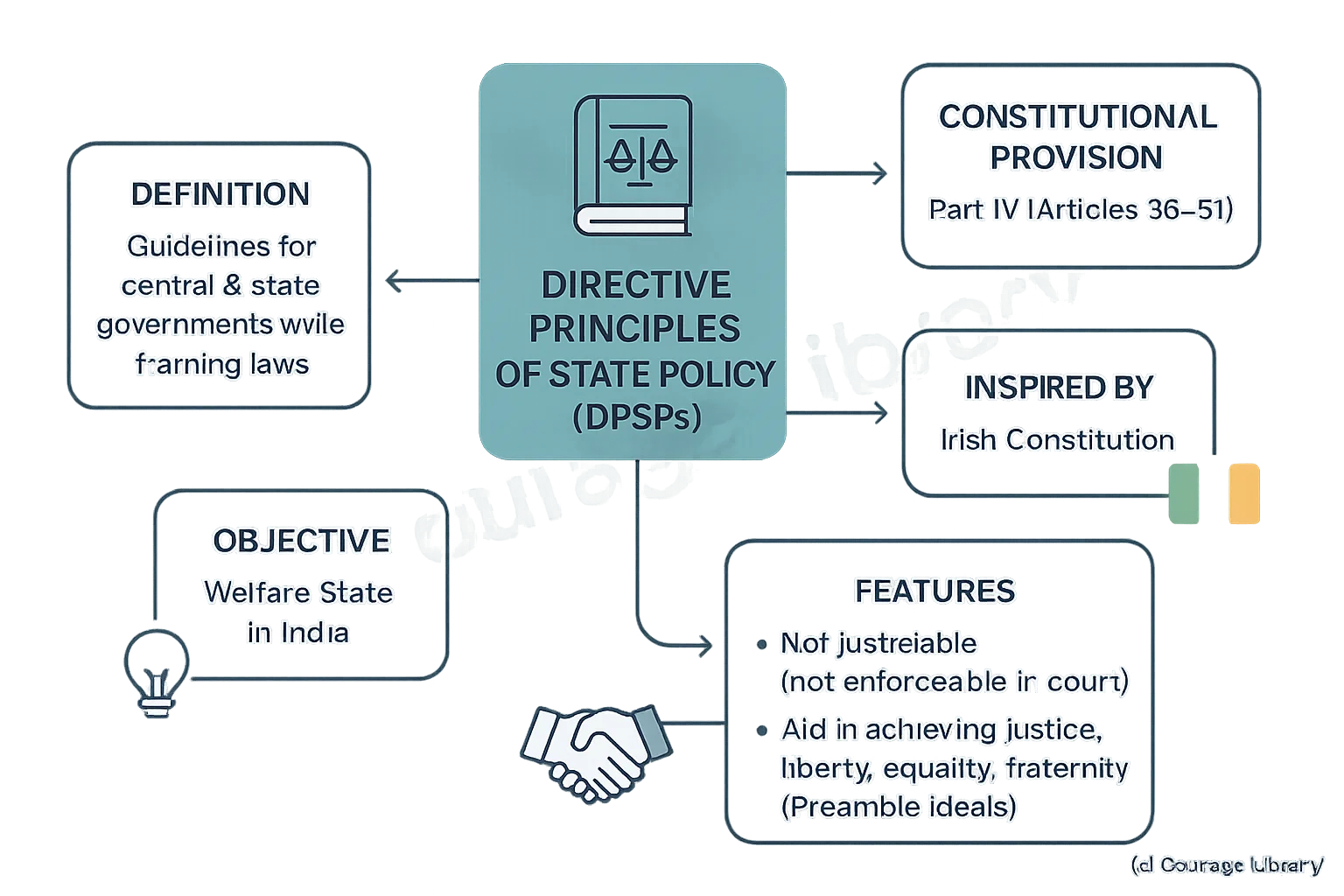SSC CGL - Detailed Guide 2025
Self-Paced Course

Directive Principles of State Policy
Reference: Lucent GK, NCERT Class 6–12
1. What are DPSPs?
- Directive Principles of State Policy are guidelines or principles given to the central and state governments to be kept in mind while framing laws and policies.
- Enshrined in Part IV of the Constitution (Articles 36 to 51).
- Inspired by: Irish Constitution (Ireland)
- Objective: Establish a Welfare State in India.
- Note: Not justiciable (not enforceable by any court).
- Help in achieving the ideals of justice, liberty, equality and fraternity in the Preamble.

2. Classification of DPSPs
DPSPs can be classified into 3 broad categories:
A. Socialist Principles → Promote social & economic equality
| Article | Directive |
|---|---|
| 38 | Promote welfare of the people, reduce inequality |
| 39 | Equal pay for equal work, prevent concentration of wealth, right to livelihood |
| 41 | Right to work, education, and public assistance |
| 42 | Humane conditions for work and maternity relief |
| 43 | Living wage and decent standard of life |
| 47 | Raise level of nutrition and public health |
B. Gandhian Principles → Reflect Gandhi's vision of self-reliant rural India
| Article | Directive |
|---|---|
| 40 | Organisation of village panchayats |
| 43 | Promote cottage industries in rural areas |
| 46 | Promote education and economic interests of SCs, STs and weaker sections |
| 47 | Prohibit consumption of intoxicating drinks and drugs |
| 48 | Prohibit slaughter of cows and improve breeds of cattle |
C. Liberal-Intellectual Principles → Promote ideals of liberalism & international peace
| Article | Directive |
|---|---|
| 44 | Uniform Civil Code for all citizens |
| 45 | Free and compulsory education for children up to 14 years (now moved to Article 21A as a Fundamental Right) |
| 48 | Organisation of agriculture and animal husbandry |
| 49 | Protect monuments and places of national importance |
| 50 | Separation of judiciary from executive in public services |
| 51 | Promote international peace and security |
3. Important Articles (36 to 51) -- Quick Snapshot
| Article | Subject |
|---|---|
| 36--37 | Definition and application of DPSPs |
| 38 | State to secure social order |
| 39 | Principles of policy (equal pay, livelihood, childhood care, etc.) |
| 39A | Equal justice and free legal aid (added by 42nd Amendment, 1976) |
| 40 | Village Panchayats |
| 41 | Right to work, education, public assistance |
| 42 | Humane conditions at work and maternity relief |
| 43 | Cottage industry and living wage |
| 43A | Participation of workers in management of industries (42nd Amendment) |
| 44 | Uniform Civil Code |
| 45 | Childhood education (now shifted to Fundamental Rights under 21A) |
| 46 | Promotion of weaker sections' education & economy |
| 47 | Raise nutrition and health level |
| 48 | Agriculture and animal husbandry |
| 48A | Protection of environment (added by 42nd Amendment) |
| 49 | Monuments and heritage sites |
| 50 | Separation of judiciary from executive |
| 51 | Promotion of international peace |
4. Comparison: Fundamental Rights vs. DPSPs
| Feature | Fundamental Rights | DPSPs |
|---|---|---|
| Part of Constitution | Part III (Articles 12--35) | Part IV (Articles 36--51) |
| Nature | Justiciable (enforceable in court) | Non-justiciable (not enforceable in court) |
| Aim | Establish political democracy | Establish social and economic democracy |
| Target | Individual rights | Directive to the State |
| Supremacy (Original) | Fundamental Rights | Subordinate to FRs |
| Amendments | 42nd Amendment gave DPSPs greater importance | Court may enforce DPSPs indirectly via judgments |
Landmark Case: Minerva Mills v. Union of India (1980)
Supreme Court: "Harmony should be maintained between Fundamental Rights and DPSPs. They are
complementary and not contradictory."
Developed By Satyam Kumar
Next
Start Your Polity Preparation Now!
Join Courage Library to experience disciplined study and expert support.
Be a Couragian!